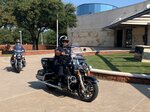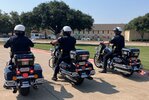



Three weeks on the streets, and Farmers Branch Police Department’s (FBPD) first motorcycle traffic unit has already made a difference.
Drivers have been so responsive to the motorcycles that officers see a decrease in traffic speeds within two hours of going on shift.
Even those being ticketed for driving infractions such as going 20 miles per hour over the speed limit have received their citations with an unexpected pleasantness because of the bikes, said Officer E. Goodrum.
If they contact 25 drivers daily, they all respond positively, which is not how people commonly respond to being stopped by a squad car, he said. “I just don’t know what the difference is. It’s odd.”
Goodrum said traffic is the community’s top complaint to the police department.
“The roads are being more Mad-Max style,” he said, citing the post-apocalyptic movie series originally starring Mel Gibson. “We’ve already started seeing a difference in two weeks.”
Officers with the traffic unit are tasked with stopping only traffic violators, focusing on speeding drivers, so the interaction with drivers is quick. Because they don’t have computers on their motorcycles, they don’t run license plates through databases to look for stolen cars, outstanding warrants or do investigations like officers in squad cars do.
However, because they are on motorcycles, officers find it easier to check drivers’ speeds with radar or LIDAR, a type of radar that uses pulsed infrared laser light, devices because they can rotate their backs easier on the motorcycle than they can sitting in a car, said Officer A. Carrillo. The motorcycles themselves also make catching drivers easier because they aren’t as easy for drivers to see so they don’t try to slow down as they do when they spot a squad car, and motorcycles can take off and maneuver much quicker than a car.
The traffic unit operates in teams of two motorcycle officers working 12-hour shifts, seven days a week, on Harley-Davidson 114 Road King motorcycles, which have Milwaukee-Eight 114 engines that are 1,868 cubic centimeters.
The officers were chosen by their willingness to stop traffic infractions, the personality to work long days with the public and a desire to learn to ride the motorcycles, which was not an easy task.
The officers attended the Texas A&M Extension Service Basic Police Motorcycle Operator training in College Station, which is an 80-hour, two-week class, most of that time spent on the Harley-Davidson Road King motorcycles, where officers learned how to handle the bikes all the way to the edge of the bikes’ capabilities.
By comparison, the Texas Department of Safety requires regular motorcycle drivers take a motorcycle safety class that is only about 10 hours of riding time over two days for beginner riders to get their motorcycle certification.
Dropping the 840-pound motorcycles was imperative during the lessons, though most riders do their very best to avoid that, and it is highly discouraged during the regular motorcycle safety classes.
The officers said they dropped the bikes 10-30 times a day for two weeks.
“I’m an expert at picking up a bike now,” Goodrum said.
Falling came with a multitude of scrapes and bruises, the officers said. Goodrum pulled out his phone to show a photo of how the sole was ripped off the bottom of his uniform police boot.
Of the three officers interviewed by the Branch Herald, only Goodrum said he had extensive experience riding motorcycles before the training, which was a disadvantage.
“They told us we had no bad habits,” Moreno said.
“The training was ridiculously hard for me,” Goodrum said. He said he’s been riding motorcycles since he was four.
Carillo said that he started riding a motorcycle after he was chosen for the traffic unit and about a month before training started. He said that maneuvers, such as turning around the bike in his driveway, that were very difficult before the training have become “a piece of cake.”
“We had to learn to do the hard things you wouldn’t do as a normal rider,” Moreno said. “To get a violator, you’re not just giving gas. You might be doing a sharp turn, a hard turn with things around you … It’s amazing what I can do on a motorcycle that I couldn’t have even imagined” before the training."
While officers will focus on traffic, the department anticipates they will also be called for active robberies, burglaries and active shootings, though Goodrum said everyone hopes for none of those. The motorcycles are stocked with the same gear as squad cars so officers will be prepared for any scenario.
“We’ll most assumably get their first,” Goodrum said, because of their ability to cut through sidewalks and between cars.
The officers said that their uniform and gear is a bit different than it was when they rode in squad cars. They wear load-bearing vests with their gear instead of belts, which puts the weight on their shoulders and relieves pressure from their hips.
When the correct-size boots arrive, all the officers will wear the tall leather boots that protect their calves from the heat of the exhaust and yet provide them mobility for walking.
The officers joked about having good tans from being in the sun and heat this summer.
“We just assume three to four months of the year will be hard,” Moreno said, referring to July, August, January and February.